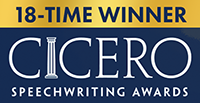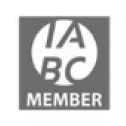How to write speeches: 5 burning questions asked and answered
 Are you a business communicator or leader who struggles to create a speech or presentation?
Are you a business communicator or leader who struggles to create a speech or presentation?
Here are five burning questions that communicators and leaders have been asking about how to write speeches.
We had a lively discussion during my breakout room session at the virtual HERStory Business Communication Expo presented by IABC Greater Cincinnati.
Attendees were professional business communicators writing speeches for executives, and leaders creating presentations to support their own businesses.
I began by asking attendees this question:
“What’s the biggest struggle you face when you create a speech or presentation?”
Attendees were eager to share their top struggles – and in 25 minutes, we’d had a rich discussion around all of them.
Here’s a recap of the top five questions about how to write speeches, plus the highlights of what we discussed.
Question 1: “I always wonder and worry: Who really cares about MY story? Is my message really any different from what others have already said?”
Answer:
Yes, people care about your story – IF you tell it in a way to make them care.
Think about it: Let’s say you want to do a speech on leadership, or some aspect of leadership.
No doubt there have been a million or more speeches on leadership since the beginning of time!
But no one else has had your exact experience with leadership.
Recognizing this truth – and then honoring it – is key.
- What was your experience with leadership?
- Can you use this experience to make a point about leadership that will stick with your audience?
- Can you share your story in such a way that gets your audience to think about leadership in a way they haven’t thought about it before based on your one-of-a-kind experience and perspective on it?
 Question 2: “How do you capture another person’s voice when telling their story in a speech (especially when you’re only given a couple of sentences about the story itself?)”
Question 2: “How do you capture another person’s voice when telling their story in a speech (especially when you’re only given a couple of sentences about the story itself?)”
Answer:
If you’re writing for an executive and need to capture his or her voice, you must spend some time actually listening to that person’s voice.
I know: Executives are busy – they don’t have much time!
But even a little time can help a lot.
You know this, of course. (It’s amazing what nuggets you get if you ask just the right questions and then listen!)
But here’s the catch:
Many executives do not know this.
In thinking about how to write speeches, they might believe if they toss out a sentence or two, a speechwriter can spin gold out of straw. (Side note: The longer a speechwriter works with an executive, the more this is actually true!)
But in the beginning, a bit of time is required to hear and then capture another person’s voice.
To make this happen, you must take hold of the process and ask for what you need from the executives you support.
If you’re new to the team, and your executive gives you a couple of sentences and says, “Use this story for my award acceptance speech,” be bold enough to say:
“Could I get 30 minutes to ask a few questions and get what I need for this story?”
Then honor your word.
Meet for just 30 minutes.
Go in well-prepared with just the right questions to get every last detail, every insight you’ll need.
 Question 3: “How can I create a rhythm for updating my core workshop presentation with current data so it doesn’t get stale over time?”
Question 3: “How can I create a rhythm for updating my core workshop presentation with current data so it doesn’t get stale over time?”
Answer:
Create a procedure to batch process these updates so you can be more efficient when your presentation is ready for a refresh.
For example:
- When you come across new data that would be perfect for your presentation – a study, a statistic, a story, a trend, a news clip – take 5 seconds and move it to a “Presentation Updates” file in your computer.
- Every three months or so, block out an afternoon to review all you’ve collected. Then decide what new data to add and what old data to subtract. (A short timeline here, perhaps once a quarter, makes the process feel like a small task rather than A Great Big Project that you might tend to avoid.)
- Make all the fixes in one fell swoop.
- Practice and rehearse your now up-to-date presentation. (Don’t skip this part!)
Scheduling time routinely to batch process any updates into your core presentation will eliminate the need to frantically update your talk the night before a workshop (which not only prevents you from being well-prepared but also increases your chances for errors).
 Question 4: “I’ve just begun supporting a senior executive and need to learn more about how to write speeches. I struggle with confidence to ask the right questions and really dig in. Any tips?”
Question 4: “I’ve just begun supporting a senior executive and need to learn more about how to write speeches. I struggle with confidence to ask the right questions and really dig in. Any tips?”
Answer:
You can start to gain confidence by carving out time to first break the ice.
Since you’re new to this role, ask for a two-hour Q&A block so you can start to get to know your executive and begin to build trust.
Before the Q&A, be smart: Do research online about your executive to gather information that already exists. The right research will prompt you to craft better questions that are intentional, thoughtful and specific.
Then – based on your research, the culture of your organization, and your experience to date with this executive, ask yourself: What do I need to know and understand?
Your research and the right questions will lead you to where you need to go.
During the two-hour Q&A, dig deep: Start with the executive’s childhood and family background; then ask about the executive’s journey with education, career, family, community, and personal and professional interests, experiences and milestones.
If you build a strong foundation early on – collecting basic facts, details, values, key phrases and stories about your executive’s life – you’ll have essential material “in the can” that you can draw on later to kick-start good ideas and mine supporting stories for future speeches and presentations.
 Question 5: “How can I best help executives at each end of the spectrum – from those who always sound stiff (because they stick so closely to their script), to others who are comfortable riffing (that they wander away from the point)?”
Question 5: “How can I best help executives at each end of the spectrum – from those who always sound stiff (because they stick so closely to their script), to others who are comfortable riffing (that they wander away from the point)?”
Answer:
Rehearsals and coaching must always be part of the process.
It’s never enough to only deliver a complete script (to the executive who needs a full script), or a page of talking points (to the executive who likes to be a little spontaneous).
At that point, you’re only halfway there.
To do your job, set the stage and the tone right from the beginning.
Explain to your executive how the process will go, from start to finish.
You drive the train.
If rehearsals and coaching are part of the process – and that’s known from the start – you and your executive can plan for it.
And – more importantly – allot enough time for it.
Do you have a burning question about how to write speeches?
Email me here!
Do you want to learn how to work with a speechwriter?
Get your FREE GUIDE here!

















